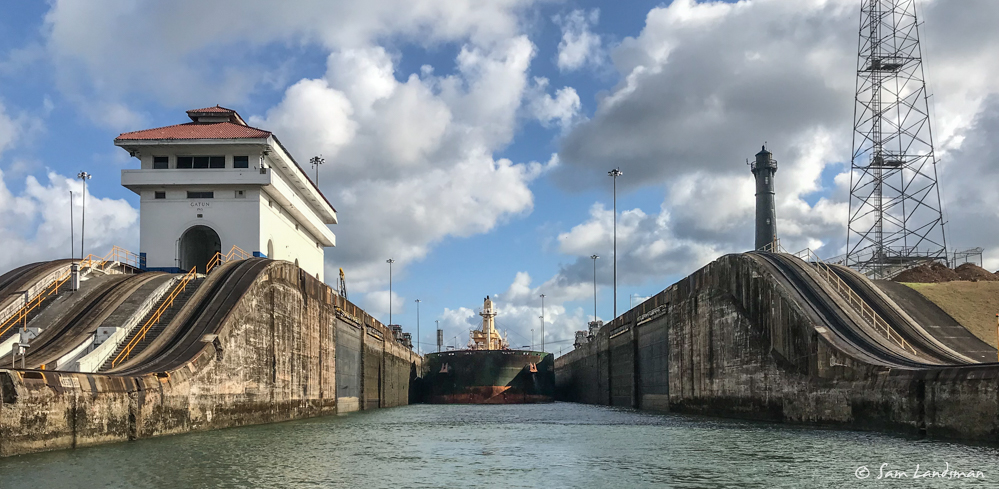The Panama Canal is a crossroads of the maritime world. About 40 ships a day transit the canal, ranging from yachts to warships and everything in between. It’s a critical economic link between the West Coast and East Coast of the Americas, a monumental civil engineering project, an important political achievement, and a milestone for cruisers. The vast majority of circumnavigating yachts transit the canal, and hundreds of cruisers who aren’t circumnavigating use the canal to pass between the Atlantic and Pacific every year. Transiting aboard a small boat has long been a goal of mine, not because it’s particularly challenging or beautiful but because it’s momentous, symbolic, filled with history and the promise of exciting things to come on the other side.
So when I got an email from Eric inviting me to fly down to Panama to transit the canal aboard Sprezzatura, his Nordhavn 40 that I’d crewed on last year from San Diego to La Paz, I booked flights.
History of the Canal
Much of the allure of the canal comes from its history. Before the canal was constructed, ships transiting between the Pacific and Atlantic had two choices: the long, perilous journey around Cape Horn and through the Drake Passage, or the longer (but perhaps more settled) trip around the globe via the Pacific and Indian oceans. Spanish explorers conceived the idea of a canal across the Central American isthmus in the mid 16th century, but it wasn’t until the late 19th century—after the successful construction of the Suez Canal—that the forces of technology, geopolitics, and personalities converged to make a serious attempt at construction.
Ferdinand de Lesseps, the charismatic Frenchman who rose to prominence by successfully developing the Suez Canal, became the face of the Panama Canal in the 1880s. He tirelessly promoted the project and raised hundreds of millions of dollars from investors. His company planned a sea level canal, like Suez, which would have required excavating an estimated 157 million cubic yards of earth. Construction began in 1881 but ended in bankruptcy in 1889. More than 20,000 lives were lost to malaria and yellow fever, hundreds of millions of dollars of investor money vanished (many of whom were unsophisticated investors who poured their entire savings into the endeavor), and the canal was never completed.
Undeterred and recognizing the strategic importance of a canal linking the Pacific and Atlantic, Teddy Roosevelt took up the cause at the turn of the 20th century. After much debate, American politicians and engineers settled on a plan to dam the Chagres River, which would create a large lake, build a series of locks at each end of the lake, and dredge a navigable channel through the lake. The canal finally opened in 1914, overshadowed by the outbreak of World War I. The scale of the project was mammoth, even by today’s standards: nearly 240,000,000 cubic yards of earth was moved, 75,000 laborers were involved, $375 million (about $10 billion today) was spent, and 6000 lives were lost (not including the casualties from the French attempt). At the time it was the largest civil engineering and construction project ever completed by mankind.
The successful completion of the Panama Canal—and its enduring importance—is inspiring, a monument to human ingenuity and perseverance. The complete history, of course, is considerably more sordid and complex than described above. History buffs or cruisers heading for the canal should read The Path Between the Seas, David McCullough’s authoritative history of the canal.
Arriving in Panama
When I arrived in Panama City, Sprezzatura was on the hard at Flamenco Marina. Most scheduled maintenance had been completed, but the Naiad stabilizer fin seals still needed to be replaced. Eager to learn what’s involved in this maintenance (I’m not buying another boat without some form of stabilization…it’s that good!), Eric and I set to work. The process proved surprisingly easy and we had everything back together in less than four hours of working time. With the fins reinstalled, we were ready to launch.


We had a few days before our scheduled canal transit, so we motored to La Playita anchorage and dropped the hook. La Playita is an acceptable anchorage, popular primarily because the nearby marinas are pricey. The anchorage itself has sweeping views of the expansive Panama City skyline, but every ship and pilot boat transiting the canal passes nearby, and their wakes, plus the Pacific swell, make this a very rolly anchorage. Thankfully, watching the ships is part of the fun. We spotted the USCG cutter Hamilton, several LNG carriers, and dozens of enormous freighters, tankers, and cruise ships.
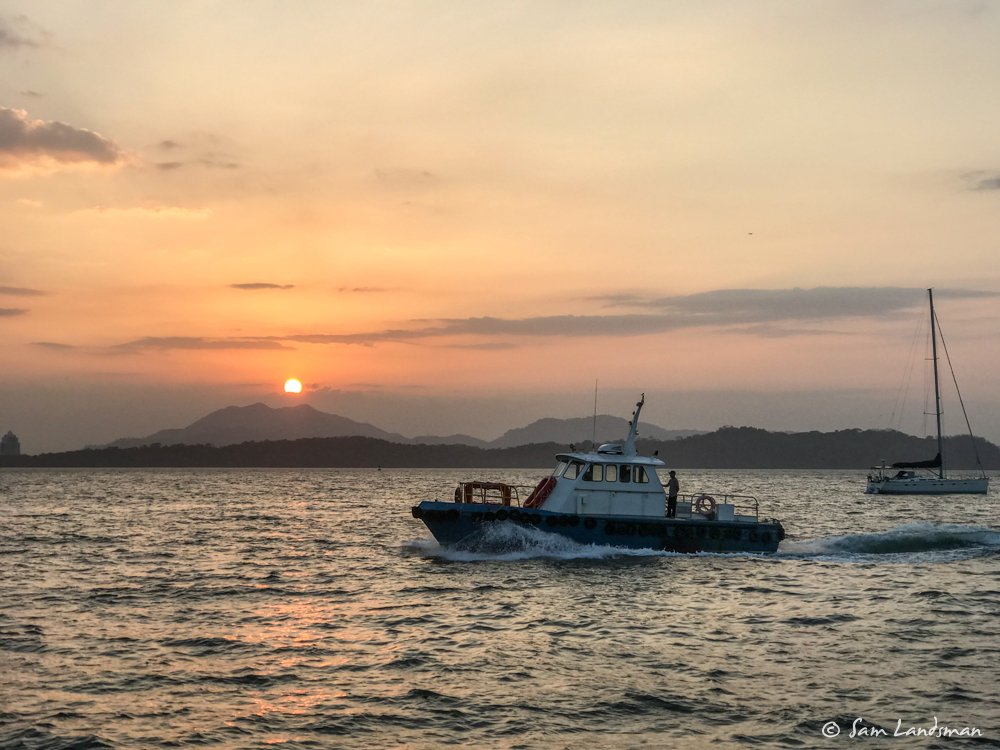
The boating scene in Panama is entirely different from the Pacific Northwest. The few local boats were big sportfishers and large, flashy euro-style powerboats. The cruising boats were comparatively modest, almost entirely sailboats in the 35- to 60-foot range, all from far away: France, the Netherlands, Denmark, Sweden, Australia, New Zealand. Except for a Nordhavn 68, we were the only cruising powerboat. The captains and crews we spoke with were friendly, helpful, knowledgable, and far more focused on the places they’re going than the gadgets aboard. Many liveaboard and most had already crossed an ocean. It was a good reminder that cruising doesn’t require a big, expensive boat or the latest electronics.
While we waited for our date with the canal, we explored Panama City, went on a bird watching tour, visited the Miraflores Locks and Panama Canal Visitor Center, and fixed a few things onboard.

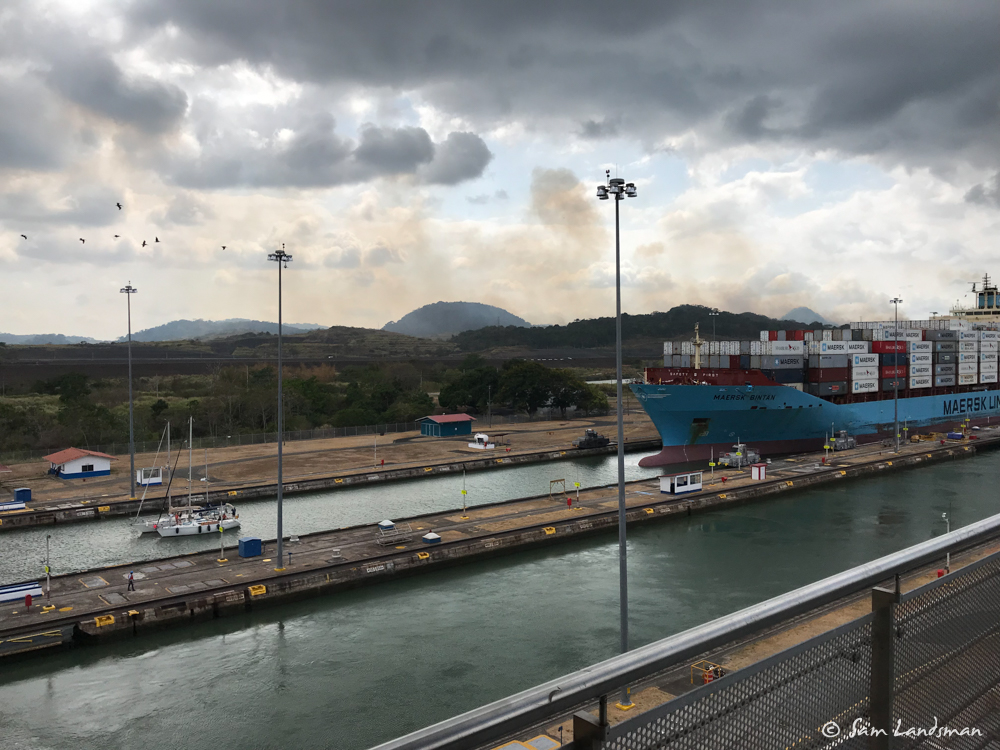
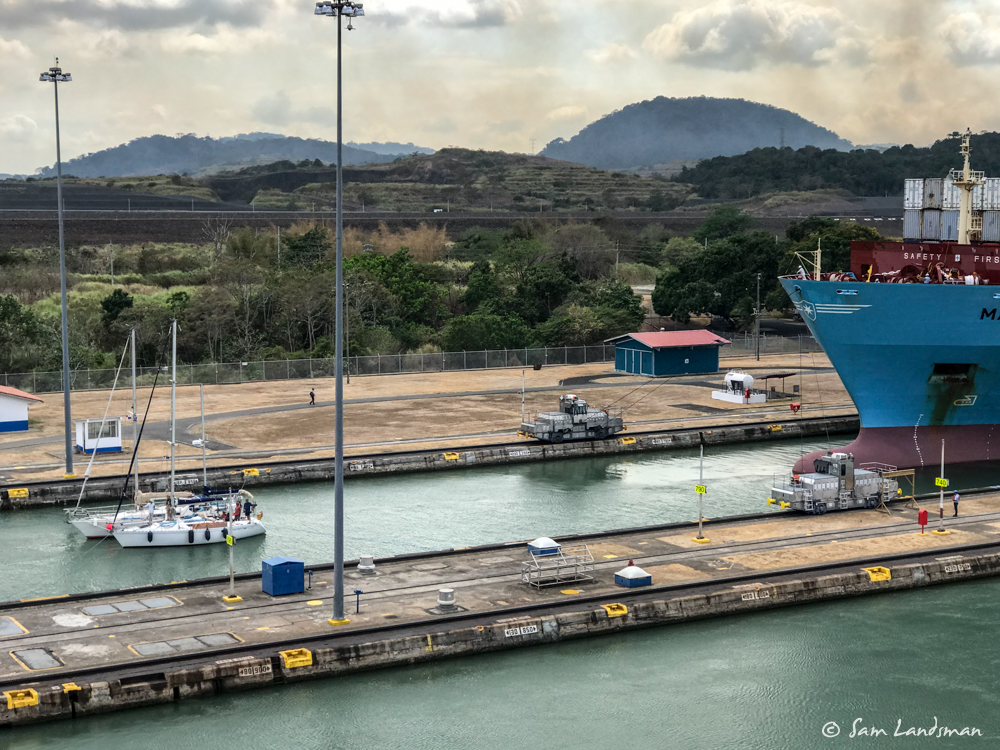
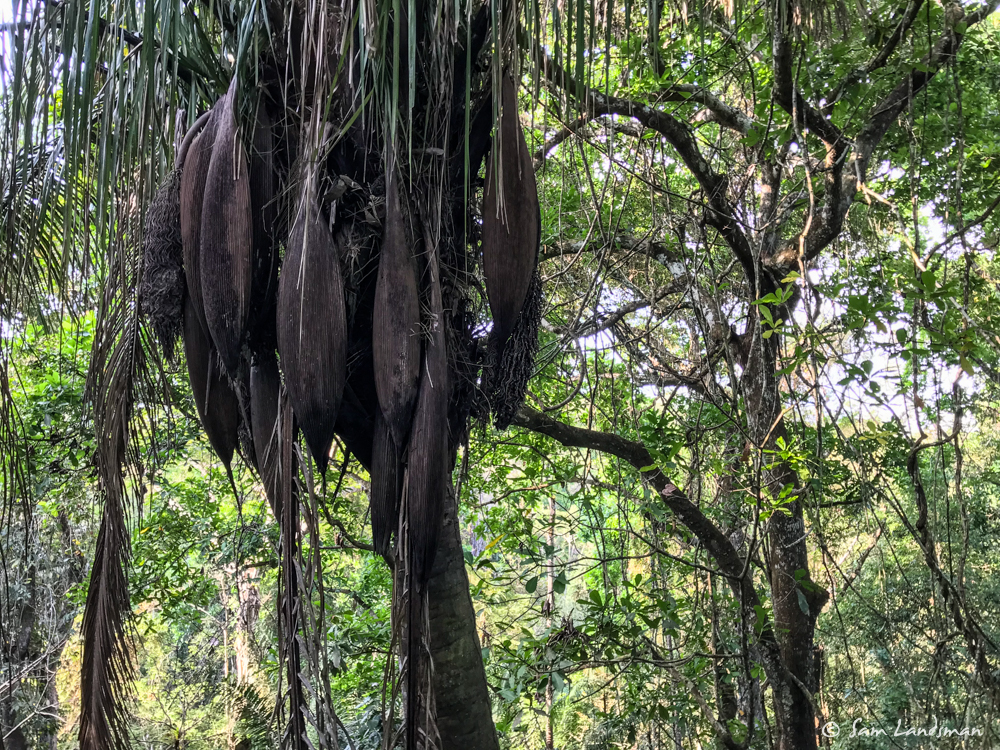
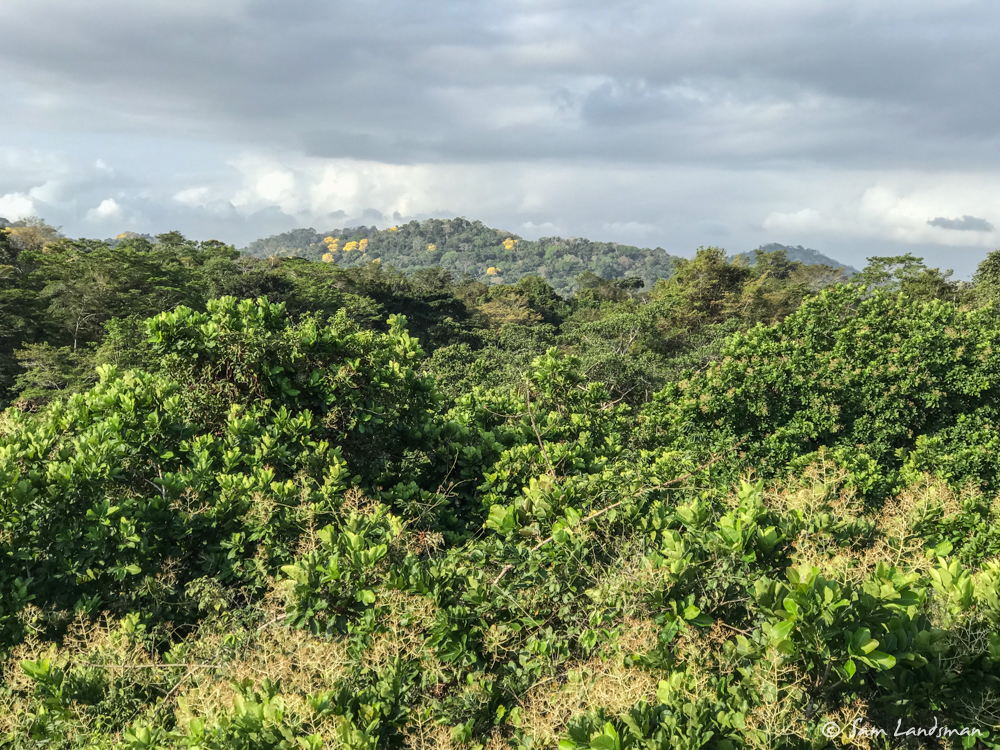
Panama impressed, with relatively modern infrastructure (yay for potable tap water!), diverse architecture, and beautiful jungle. As we explored the jungle—dense with foliage, rugged in topography, filled with potentially harmful critters—I couldn’t help but be impressed by the derring-do of the early French and American explorers who ventured across the isthmus and imagined a canal.
Transiting the Canal
Every boat transiting the canal must have a captain (usually the boat owner in the case of small cruising boats), four line handlers, and a canal advisor. Boats must also have large fenders and four 150-foot mooring lines (rent, don’t buy!). Early on the morning of our transit, we picked up our rented lines and fenders and the rest of our crew: Eric’s sister Carey, her husband Randy, their friend Gretchen, and the crew of SV Free Spirit: Jon, Kristi, and son Dylan. Then we motored out to the designated area to await Guillermo, our canal advisor.
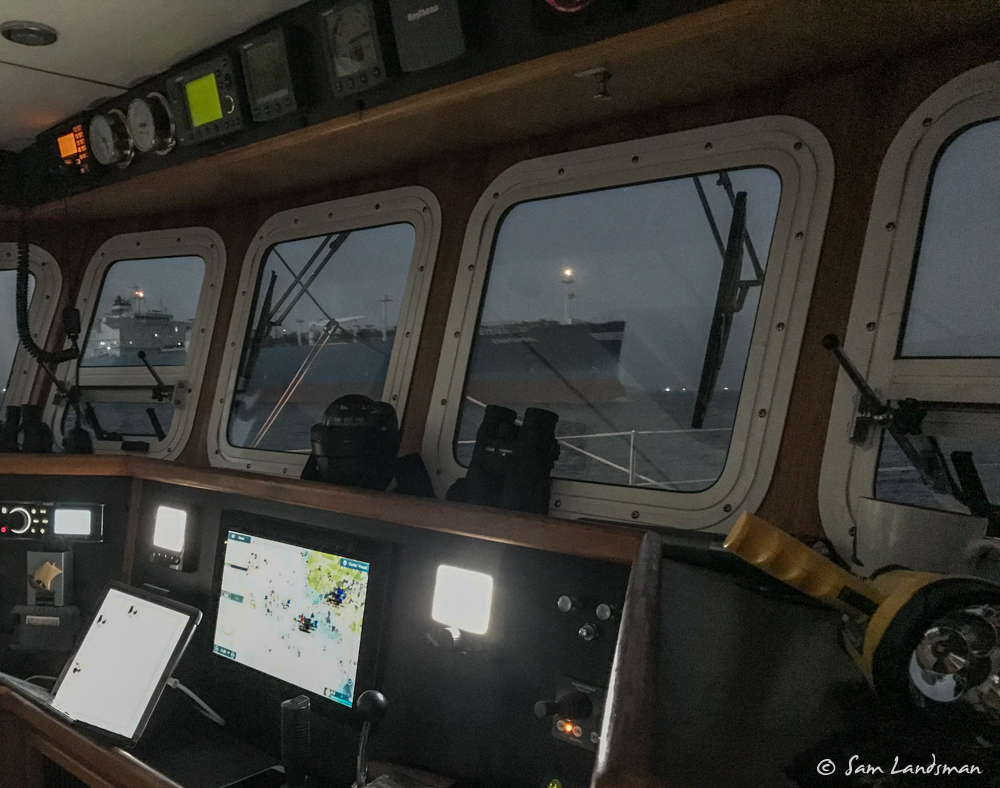
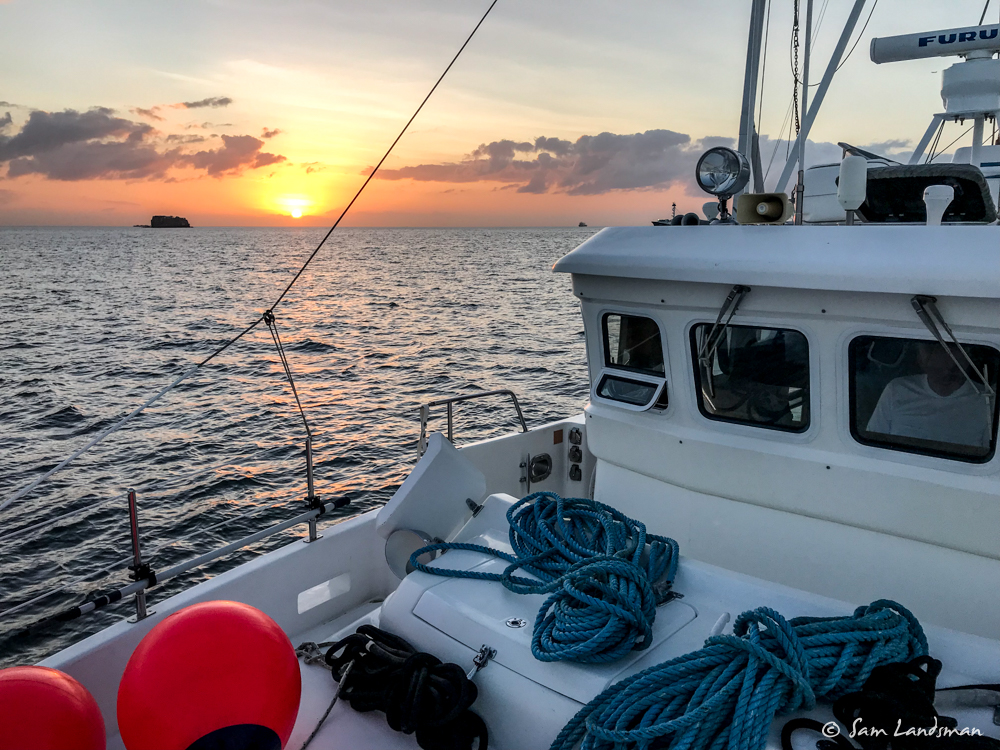
Guillermo proved helpful, knowledgable, and friendly. His full-time job is operating patrol boats for the Canal Authority, but a couple of times a week he accompanies yachts through the canal. He spoke good English, graciously answered all our questions, and gave us line handlers detailed instructions. Yachts have several choices for how they transit. They can moor directly to the canal walls, but the walls are slimy and potentially hazardous to small boats. If a tug is going through, yachts can raft on. Or they can go through in the middle of the lock—center chamber—secured by mooring lines on each corner of the boat. This keeps the boat away from the gel coat-marring walls. If multiple yachts are transiting at the same time, they can go in a raft. We transited alone, which we think made things easier, with less potential for error or drama.
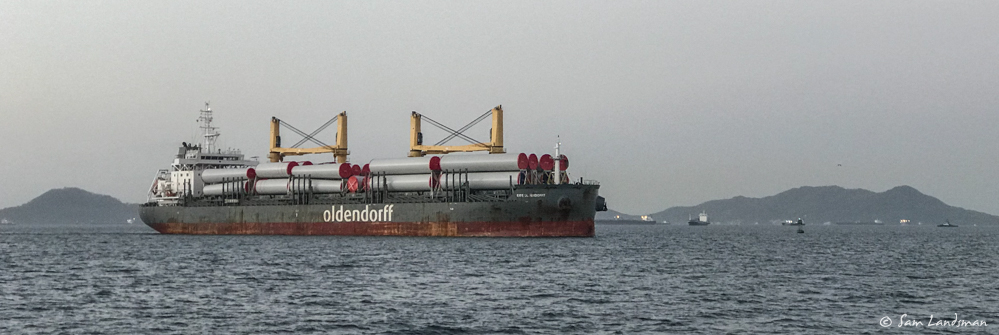
As we headed towards the first “step”, or chamber, of Miraflores lock, Guillermo explained what would happen. We’d be going up with the 600-foot break bulk freighter Eibe Oldendorff. The “uphill” part of the trip was the most challenging, he explained, since we’d be behind the freighter, subject to its prop wash, and we’d be way below the lock attendants on the lock wall. As we entered the first chamber, the lock attendant would toss us a messenger line (he was very clear that you don’t want to get hit with the monkey fist!). Line handlers on Sprezzatura would then connect the messenger line to the eye of the 150-foot dock line, the canal attendant would pull the mooring line back up to the lock wall, and secure it to a bollard. Then we were to secure the mooring line on Sprezzatura when instructed.
The biggest challenge is the rented dock lines aren’t normal dock lines. They’re huge, perhaps an inch in diameter, stiff, heavy, and coarse. Handling is best done with gloves. Wrestling with the lines particularly in 90-degree heat, is hard work.
As we entered the first chamber, everything went according to plan. Eric expertly piloted Sprezzatura into position, the messenger lines crashed aboard without injury, and the mooring lines were secured without incident. We were pleased with our performance and excited to literally reach new heights as Sprezzatura was raised almost 30 feet. During the lifting phase, the turbulence was significant—it takes just 10 minutes to flood nearly 27 million gallons of water into the chamber, all by gravity—but not problematic. Onboard Sprezzatura, each line handler pulled in the slack as we floated higher and we stayed comfortably in position. It’s not unlike going up in the big lock in Seattle, except we weren’t against the wall.

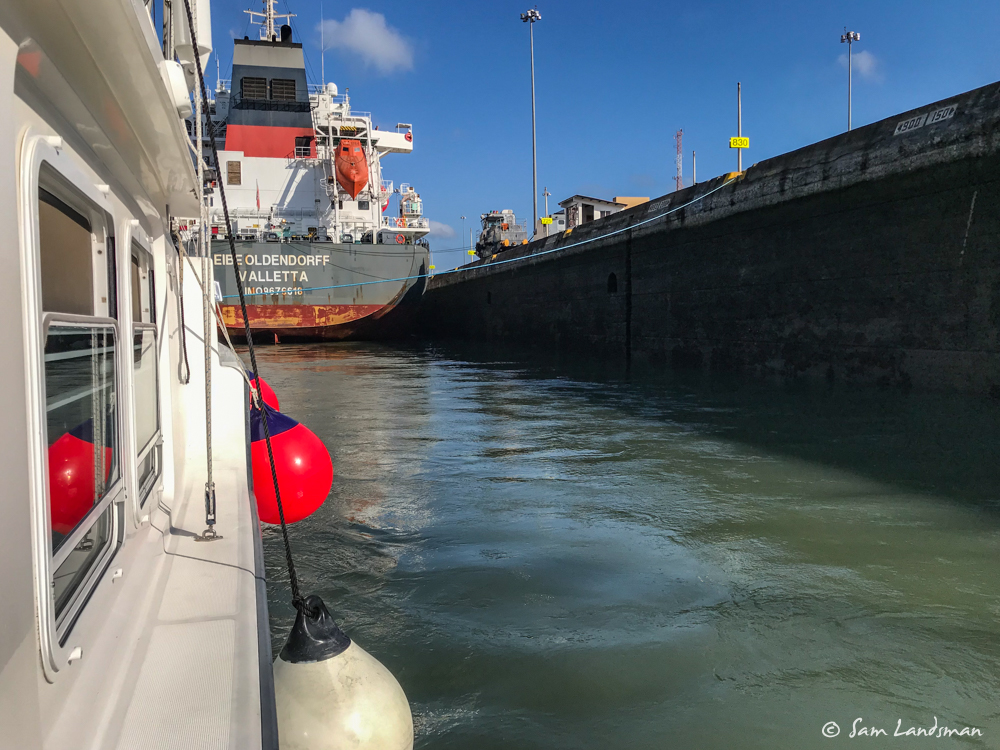
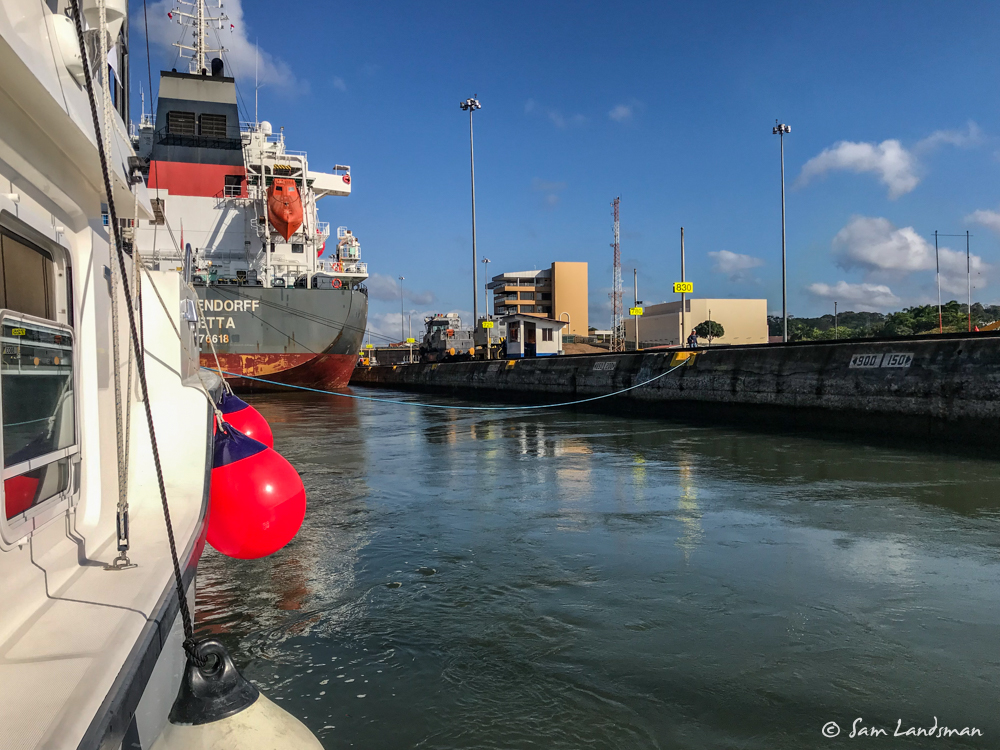
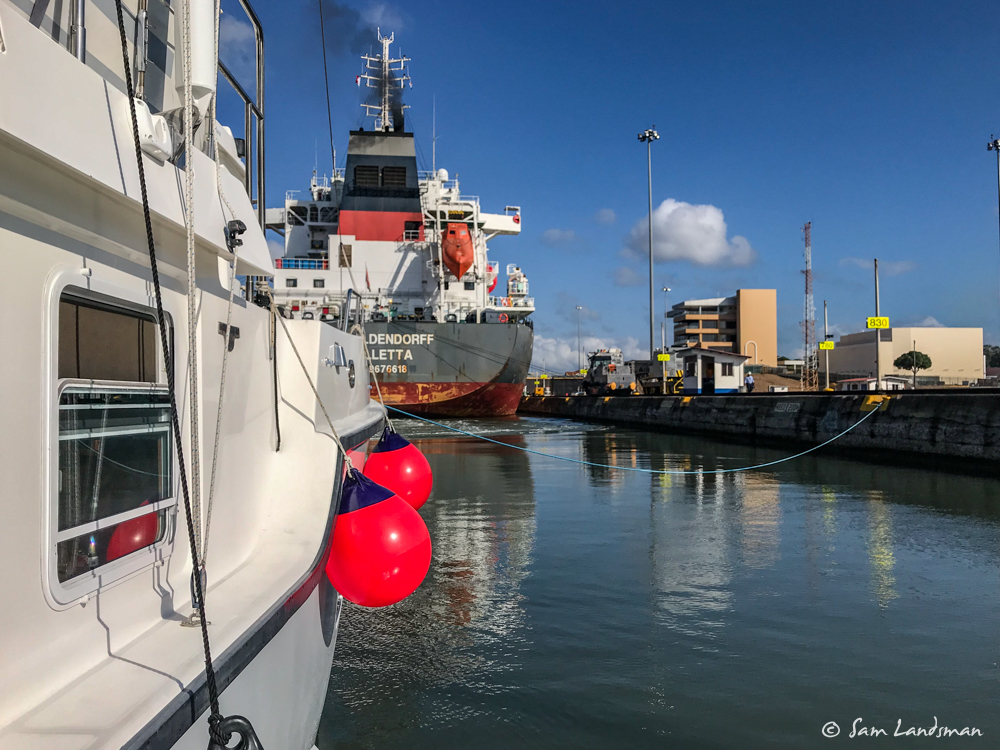
Miraflores Locks have two steps. The first chamber lifts up to nine meters, depending on the tide, then the gates open directly into the second chamber which lifts another nine meters, before exiting through the last gates into Miraflores Lake.
Vessels over 125 feet use “mules”—specialized electric locomotives with hydraulic winches—to steer and stop in the lock chambers, but they use their own propulsion to move forward. A ship shifting into gear creates severe turbulence, especially noticeable when you’re 80-feet behind it. Small boats, on the other hand, must steer and stop themselves in the lock chambers.
After Eibe Oldendorff moved into the second chamber, it was our turn. On Guillermo’s whistle, we slackened the mooring lines, the line handlers tossed them off the bollards, and we retrieved them as quickly as possible. Between the first and second chamber of Miraflores Lock, lock attendants walk with the boat, holding the messenger line. This simplifies the process since the messenger lines don’t have to be reattached a few minutes later.
The most excitement of the day occurred entering the second chamber of Miraflores Locks. The water was turbulent, almost river like, and for some reason, the lock attendants secured the bow lines to the wrong bollards, too far aft. The bow swung sharply to port, accelerating as current caught the keel, the bow thruster too weak to make a difference. The starboard bow line grew taut but at the wrong angle. From my view on the aft starboard corner, we were rapidly approaching the wall. Not knowing what else to do, I put a couple turns on the cleat. The heavy dock line groaned and the boat stopped short of the wall, but the current was still setting us onto the wall. At that point we were safe—the lock was wide enough we could have done a complete 180 while tethered by the stern cleat and not hit the wall—and we got the boat straightened out.
The rest of our transit was easier. Pedro Miguel Lock, with a single step, is the third and final uphill lock, and we lucked out. A tug was transiting at the same time, so we simply rafted alongside and enjoyed the ride.
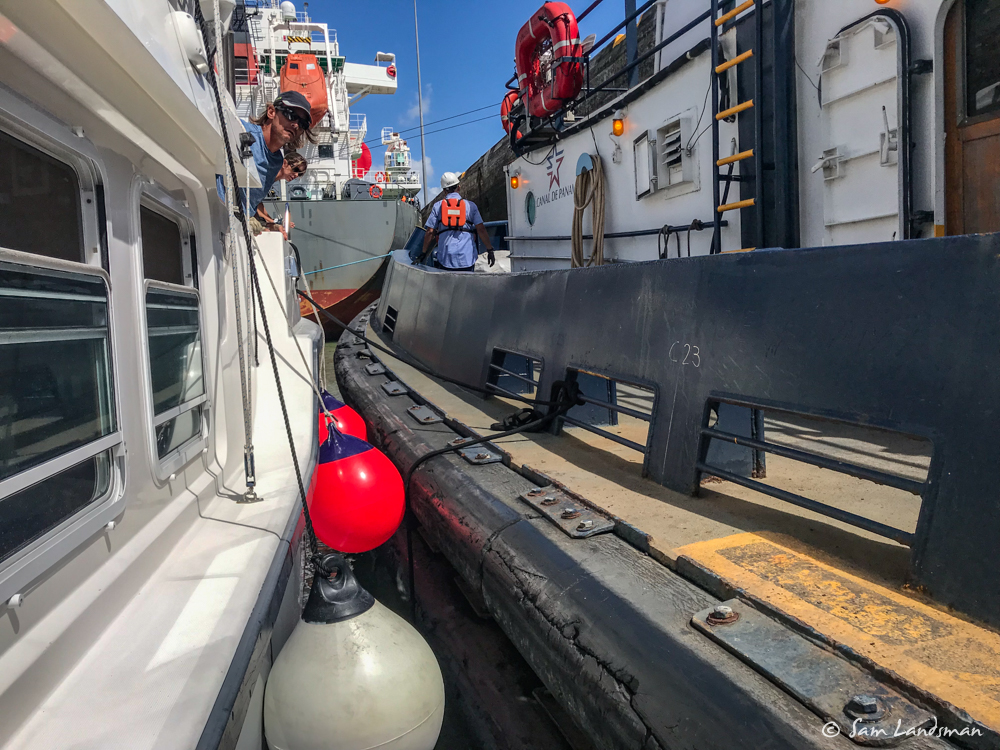
For the next five hours, we motored across Gatun Lake, elevation 87 feet. Most of the trip is in a narrow channel; large ship traffic abounds. We hugged the starboard side as 1000-footers passed in each direction, sometimes within 150 feet, so close that we didn’t dare let the autopilot drive, lest it wanders even slightly off course. Thankfully, with lots of people aboard, we took turns at the helm.
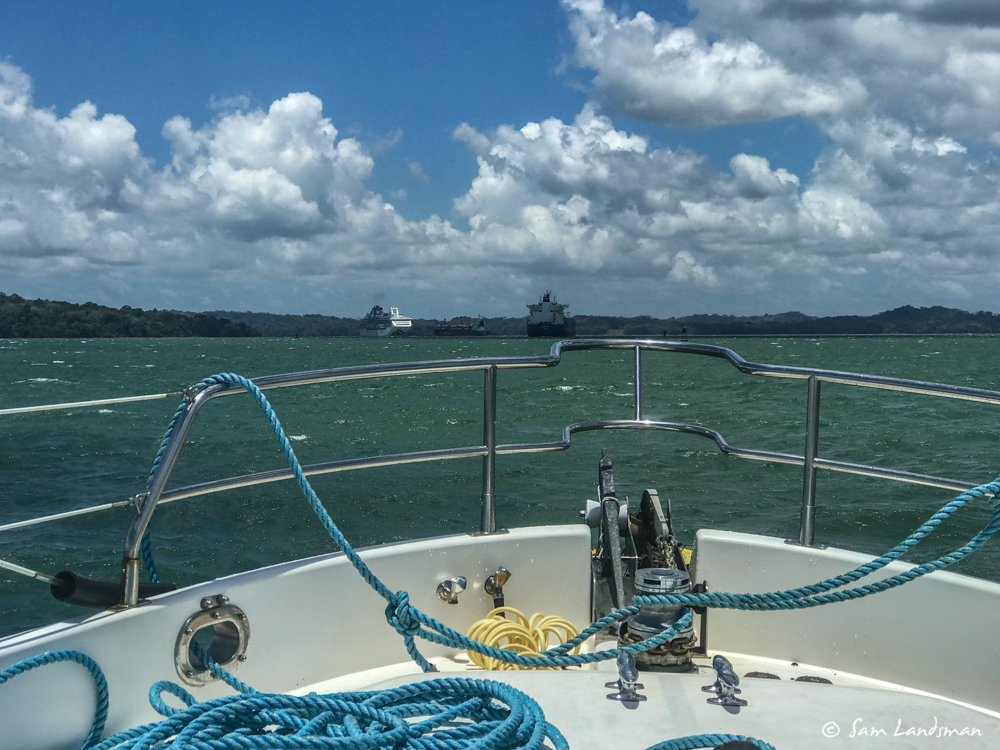
Dropping down to the Atlantic proved easy. Gatun Locks have three adjacent chambers, so the messenger lines only have to be connected once, like in Miraflores Lock. The real advantage, though, is that small boats go in front of big ships when going “downhill,” so there’s no prop wash. And during the draining process, there’s virtually no turbulence.
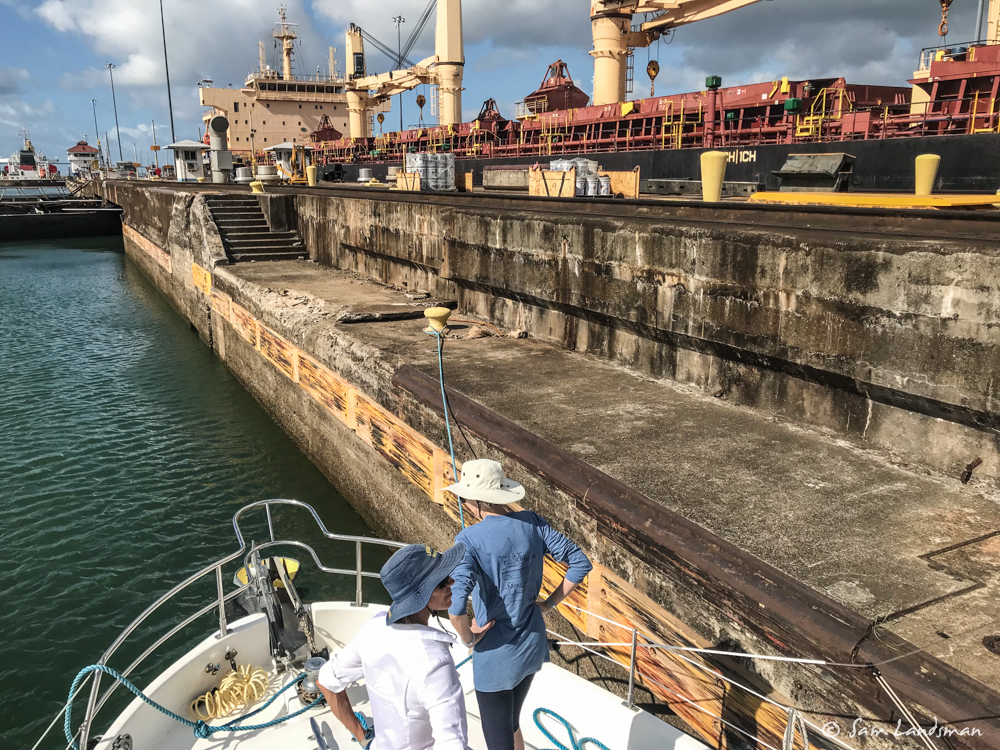
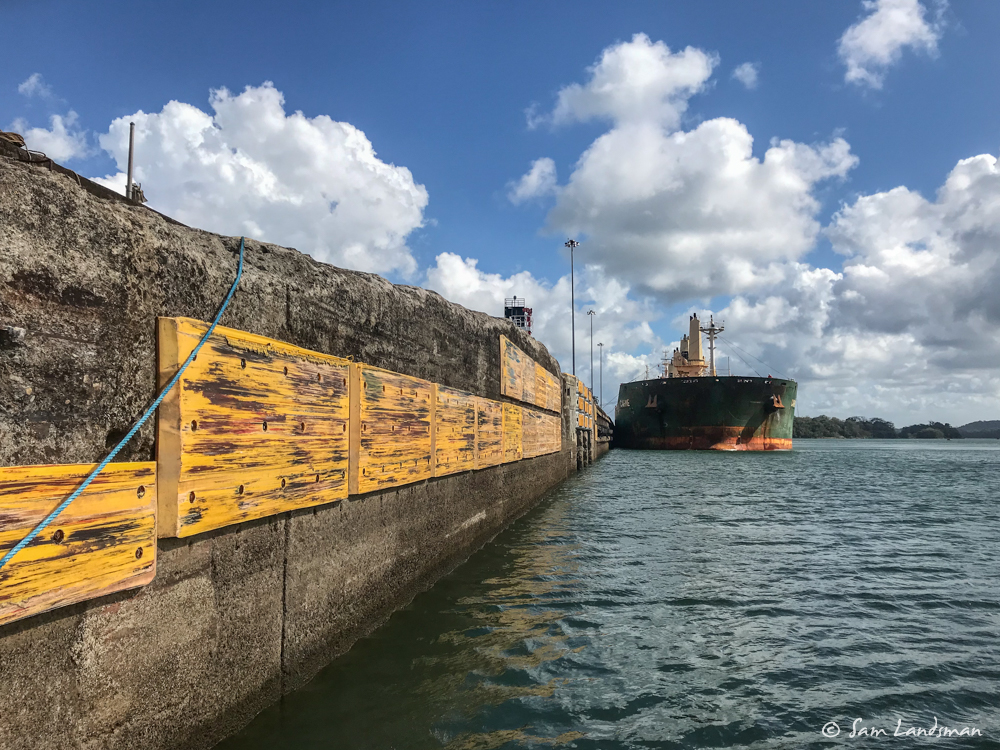
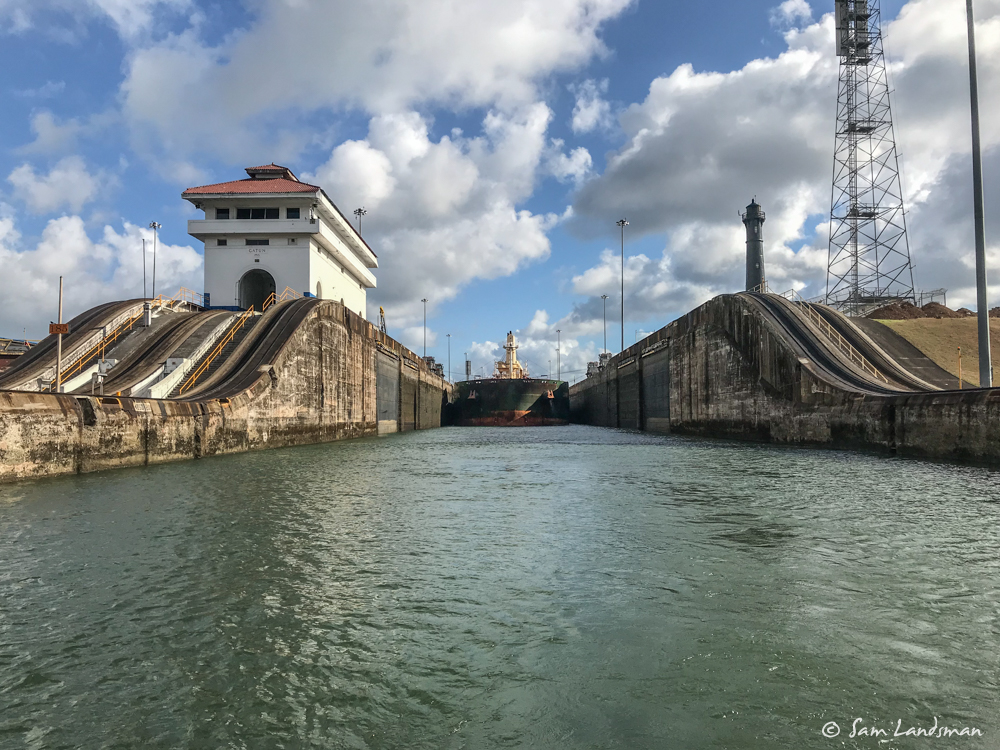
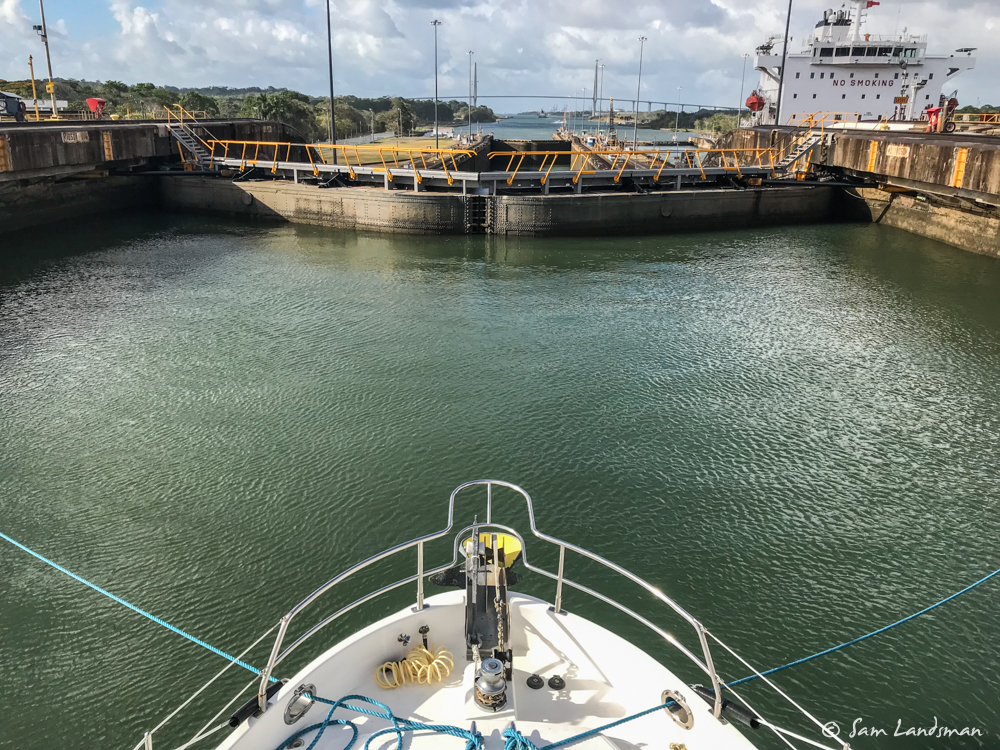
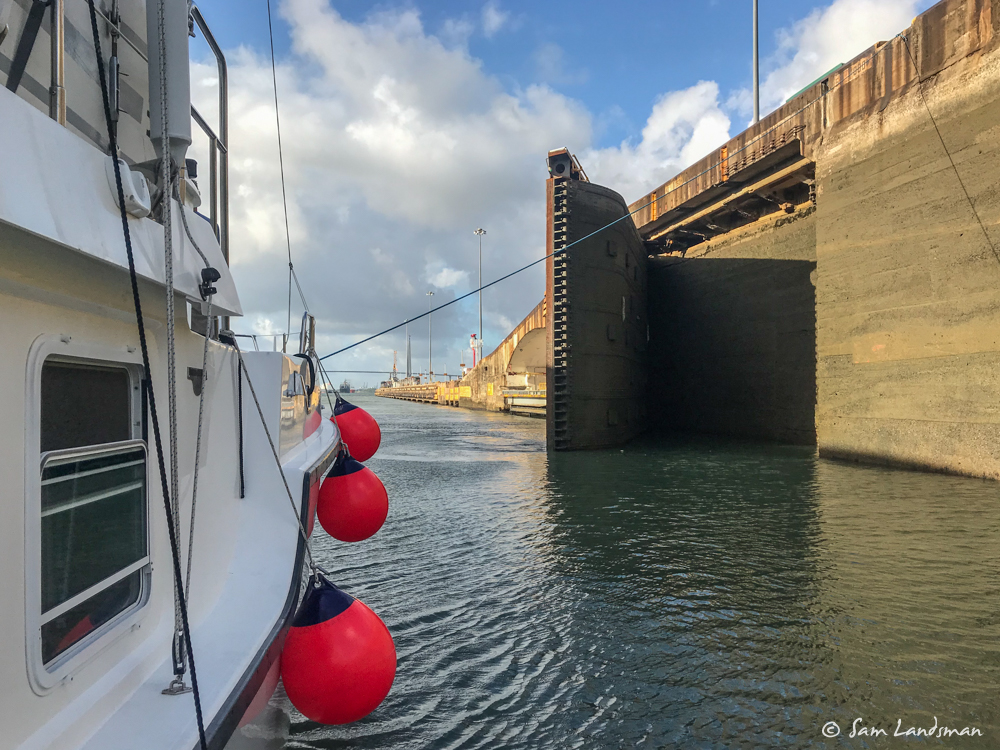
The only excitement came when one of the lock attendants accidentally severed a messenger line, then fumbled the mooring line when he got the messenger line reattached. Because the water was smooth, though, it was easy to hold the boat in position.
Soon after exiting, a pilot boat pulled alongside. We stopped while Guillermo disembarked in 25-knot winds and three-foot chop. Sprezzatura‘s beefy rub rail—a thick, two-inch wide swath of dense plastic, not some cheesy stainless and rubber thing—came in handy as the pilot boat bashed into us. Thankfully the only contact was rubrail-to-rubrail, which the Nordhavn shrugged off without a scratch or dent.
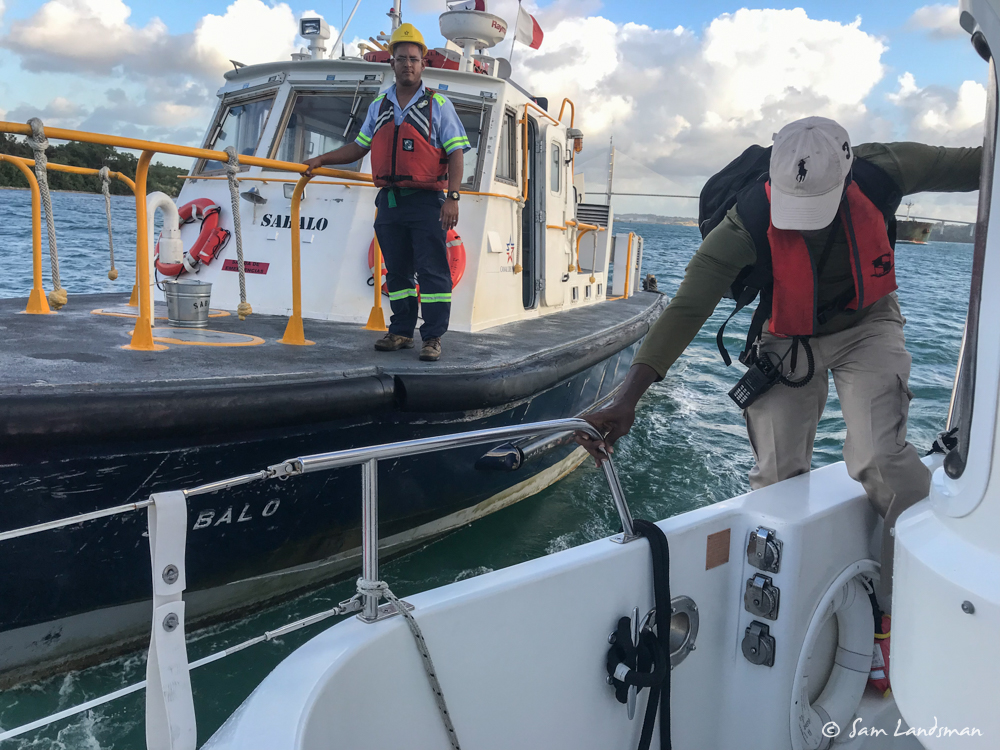
Transit day was long. We pulled the anchor at 4:30 a.m. and arrived at Shelter Bay Marina at 6:15 p.m., exhausted but exhilarated at having just crossed the Americas. Everything went well, but we all agreed that hiring experienced line handlers (readily available) would ease anxiety considerably, especially if the crew aboard aren’t experienced boaters.
Compared to the Hiram M. Chittenden Locks
Many northwest cruisers are familiar with the Chittenden Locks in Ballard, linking Lake Washington and Puget Sound. They’re very similar to the Panama Canal locks, but on a smaller scale. The “big lock” in Seattle is 80′ x 825′; each Panama Canal lock chamber is 110′ x 1050′, and the new Panama Canal chambers are considerably larger still. Both projects were constructed at approximately the same time (I’m amazed at the willingness of American leaders of that era to tackle massive infrastructure projects) and they rely on similar technology and principles. But in Panama, there are a lot more locks (two locks on the Pacific side, one with two consecutive chambers; one on the Atlantic side, with three consecutive chambers), they’re a lot bigger, there’s no small lock, and far more planning and paperwork are required to transit.

